![]()
![]()

| Modern art |
Culture and business![]() Art on the streets
Art on the streets![]() History of modern art in
Barcelona
History of modern art in
Barcelona
Famous artists and Barcelona![]() Mirˇ
Mirˇ![]() DalÝ
DalÝ![]() Picasso
Picasso![]() TÓpies
TÓpies
For cultural activities, regional government as well as business is very important. As no other Spanish city, Barcelonas business world supports and finances art and culture. This has been the case since the 19th century when Catalan manufacturers and industrialists supported Modernist artists and architects. Artists and rich aristocrats were looking for a way to express their Catalan identity, as well in politics, architecture, literature and art. They cooperated very well and succeeded in becoming independent of the Spanish traditions. The world exhibition in 1888 and, much more recent, the Olympic games in 1992, meant a revival of art in the city. Lots of projects were started, financed by the business world, and supported by the local government.
| Barcelona houses an overwhelming amount of art,
as well in the many museums as out on the streets. During the eighties, the district
council started an ambitious art project. City architect Oriol Bohigas and his successor
Josep Acebillo have chosen 150 spots in town to design parks and plazas with pieces of art
for. The main purpose was to bring the locals in touch with modern art, not to satisfy
tourists. For this reason many of the artworks are situated in the suburbs, but however,
everywhere you walk in Barcelona you will be confronted with art. It even starts when
you've walked just out of the airport, of which a wall is decorated with a huge mosaic of
Mirˇ. More of Mirˇ's work can be seen on the Ramblas, of which he designed the pattern of the pavement, and the sculpture 'Dona i ocel' at Parc Joan Mirˇ near Plaša d'Espanya. 'Dona i ocel' meaning 'woman with bird' is a high sculpture placed in the middle of a water basin in which it reflects beautifully. The Olympic Village is dominated by Frank Gehry's 'Pez y Esfera', representing a headless fish. It's a very huge structure made in a gold colored material, and you can walk underneath it. At Moll de la Fusta you'll see 'Gambrinus' the giant lobster of Javier Mariscall, and at the end of the street 'Cap de Barcelona', 'Barcelona's head' a sculpture of Roy Liechtenstein. In the Eixample area there's at Carrer Arago, on top of the Fundacio Tapies, Tapies' Nuvol i cadira', ' Cloud and chair'. This piece of art is made of three kilometers steelwire. I would consider the decorations on the Modernist buildings, especially Gaudi's, as art too. The mosaic decorations like the bench at parc GŘell have more to do with art than with architecture. In the suburbs, there is at Parc del Clot 'Rites of Spring', a metal figure of Bryant Hunt. At Parc de la Creueta del Coll is Chillida’s 'Eulogy to Water ' hanging above the pool, there is a totem of Elsworth Kelly and a sculpture of Roy Liechtenstein. Three sculptures are situated at Parc de L’Espanya Industrial, made by Anthony Caro, Pablo Palazuelo and AndrŔs Nagel. Richard Serra made a sculpture for Plaša de la Palmera. These are only a few of the many works. These works in combination with temporarily exhibits make Barcelona a free open-air museum. |
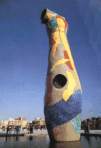 Dona i ocel |
 Pez i esfera |
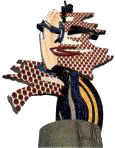 Cap de Barcelona |
Nuvol i cadira |
History of modern art in Barcelona
My view on modern art in Barcelona starts at the end of the 19th and the beginning of the 20th century. At that time Modernism was a movement that involved art, literature, architecture and politics, created to express Catalan nationalism. More about Modernism on the architecture page. Barcelona at that time was a city where artists, poets, musicians, intellectuals and political radicals gathered. CafÚ 'El Quatre Gats' was the place where some of the most important artists of that time, like Picasso, DalÝ, Mirˇ, Tapies and GaudÝ came frequently. Picasso designed the menu for Els Quatre Gats and held his first exhibition there. All the artists I named are Catalan, and however most of them didn't spent their lives in Barcelona, the city was very important to them. DalÝ founded a museum in Figueras, Picasso moved to Paris. Mirˇ lived in Paris and on the island of Mallorca, but founded in 1975 the Fundacio Mirˇ in Barcelona where many of his works can be seen. Tapies kept his works also in Barcelona at his museum Fundacio Tapies.
Famous artists and
Barcelona
Joan Mirˇ :
| Joan Mirˇ was born on the 20th of April 1893 in Montroig, not far from Barcelona. As a child Mirˇ loved
drawing, and at the age of seven he started taking his first drawing-lessons. As a young
person he studied, to please his parents, to become a merchant and combined it with art
studies. After he finished studying, he was
17 then, he worked as an accountant but he got sick, and got dismissed. He didn't mind it
as he hated the job, and from now on he could devote himself to art.
From 1912 till 1915 he took lessons at the academy of artist Fransesc d’A Gali. Mirˇ
wasn't satisfied with the way he pictured objects, and he wanted to improve his technique.
His excellent sense for colors and forms was already obvious. He liked to stay with family on the countryside of
Montroig, where he painted landscapes and scenes of farm life. Mirˇ liked to work quietly
and isolated. He wanted to show his love for the Catalan way of life to the rest of the
world, and he wanted to give an impulse to modern Catalan art. At first he was influenced by realism, later by
the colors of fauvism and the forms of cubism. His first exhibition took place in 1918,
and in that year he founded with some friends the movement Agrupacio Courbet to run
counter to the conservative art scene in Barcelona. In 1920 he moved to Paris, where he had a lot of
contact with like-minded artists and writers, whose texts and poetry gave him inspiration.
His financial situation was very bad, but artistically he was flourishing.
During this period he mixed cubist and detailed elements in his works. A good example of
this style is his work The farm (1921-22). The subjects
are still very obvious, but painted in a weird way. His works get during the following years more and
more populated with strange creatures. He told he saw these creatures during hallucinating
from hunger. Fauvist and cubist influences disappear as he now painted colorful, geometric forms and creatures who seem to float against the
background of the painting. His work becomes surrealistic. Typical for this movement were
the 'dream creatures', and the fact that the painting got formed while being painted. In 1929 he married Pilar Juncosa, and one year
later their daughter was born. At the end of the twenties, he visited Holland,
and as he admired the works of the old masters, he started to copy them in an abstract
way. At the beginning of the thirties, he experimented
with material he had found and made collages with paper, wood, sandpaper and copper. In
1932 he returned to Barcelona with his family, as the group of Paris's surrealists had
fallen apart. The Spanish civil war broke out in 1936, and had
great influence on his art. The dark paintings of
creatures in pain were typical for his so-called wild period. From 1936 till 1940 he lived
back in Paris, where he wrote poetry for some time because he didn't had a room to paint
in. He was asked to make a huge wall painting for the world exhibition in Paris in 1938. During the forties he was influenced by classical
music and the stars, the works he made were part of a series called Constellations. The beginning of WW II was the reason why he
escaped back to Spain. During the war he worked mostly on paper as other material was
scarce, but he wrote down ideas for later. He wanted to work as well with ceramics,
sculptures and graphical applications. After the war he wanted to start earning good
money with his works to be able to buy a studio. In 1947 he went for the first time to the
United States, where he worked during a few years, painting large works for example for
hotels. In 1955 he worked with ceramist Josep Llorens
Artigas at two walls for the Unesco headquarters in Paris.
This meant a real breakthrough for him. He won some important awards like an important
graphics award in Venice and in 59 he got the Guggenheim award for his work at the Unesco
building. During the fifties he was able to buy some land
and a house on Mallorca, and commissioned his friend, architect Josep Lluis Sert to build
a studio. In 1956 he moved to this house and studio, and now he had finally the room to
work on different things at the same time.During the sixties he made a lot of humorous sculptures and ceramic works, his paintings got emptier.
In 1964 opened Foundation Maeght in St. Paul de Vence, France and in 1976 the Fundacio
Mirˇ in Barcelona was founded, dedicated to his works. Mirˇ died on December 25th 1983 in Palma de Mallorca. He kept working until his death. He had been very productive : he made at least 2000 paintings, 500 sculptures, 400 ceramic works, 5000 drawings and collages, and about 3000 pieces of graphical works. |
 Mirˇ |
1940 |
1950 |
1961 |
| Salvador DalÝ was born on the 11th of May 1904
in Figueras, Spain. Even as a child he showed an impressive artistic talent, and he made
his first paintings at a very young age. At school, he was a bad and very difficult
pupil. His parents encouraged his talent and when he was 14 they let him spent much time
with their friend, the impressionist painter Ramˇn Pitchot, who encouraged the boy.
During this time he painted portraits and landscapes in an
impressionist style. At the age of 17 he started studying at the art academy of Madrid, but he was thrown off after a few months because of his difficult behavior. DalÝ must have been a strange man. He was a rebel, very eccentric in his looks as well as in the way he behaved, he wanted to be in the middle of attention, and he was more or less mentally disturbed. After he got sent off school, he returned to Cadaques, tried to calm down and devoted himself seriously to painting. He even got readmitted to the academy for some time. His paintings were influenced by cubism, until the twenties, when they became surrealistic. This style was great for him as he could express his hallucinations, fears and dreams trough his paintings. Dream analysis was very important for him, he tried to influence his dreams, and as soon as he woke up, he painted what he had been dreaming. The atmosphere and situations of his paintings are very unreal, but the subjects are reproduced very realistic. His paintings are very complex, and you have to look at them very attentive to discover all the details. His first exhibition took place in 1925 in Barcelona. His paintings were immediately popular By the public, what strengthened his belief in his own genius. From 1927 he left Cadaques regularly, to stay in Paris, where he lived among other surrealists like Picasso, Mirˇ, and filmmaker Bu˝uel. Bu˝uel and DalÝ made two surrealistic films together, "Un chien Andalou" in 1929, and "L'Age d'or" in 1930.In 1929 he met his wife Gala, she was the love of his life and his greatest source of inspiration. During the same year he joined the group of surrealists, and held his first exhibition in Paris. DalÝ wanted to earn big money with his art, and did everything to attract attention. At the beginning of the thirties, he was influenced by De Chirico, by architect Antoni GaudÝ and by the classical works of Vermeer. DalÝ didn't only paint, but made sculptures and absurd appliances too. During the thirties his works became a little more realistic. Later on he had an enormous fascination for distorted parts of the body and bones. When nazism made his entry DalÝ expressed his sympathy for this movement, which made him very unpopular by the surrealist movement. ( Surrealism and modern art in general were rejected and forbidden by the nazis.) Just before World war II broke out, DalÝ fled with Gala to the United States. Meanwhile he had become popular in the States too, through his exhibitions and lectures at the MOMA ( Museum of Modern Art ) in New York. During this period DalÝ wrote a lot at his biography. His paintings changed, geometry, mathematic figures, anatomy and perspective became very important. During his stay in America, he met film stars and celebrities, whose portraits he painted. At the end of the forties his classical period began. His colors became more romantic, and the forms lost their sharpness. DalÝ became more religious and started making religious works. He returned to Port Lligat in Spain, and in 1958 he got married with Gala in church. During the sixties he wrote a lot and his paintings showed molecular figures. The DalÝmuseum in Figueras opened in 1974. Gala died in 1982, and this meant the beginning of the end for DalÝ. Meanwhile he was diagnosed with Parkinson's disease, and he had to give up painting in 1983. He pined away and didn't want to live anymore. When a fire broke out in his bedroom he just wanted to stay inside and die, but he survived badly injured. DalÝ died on January 23th of 1989, at the age of 84, after a period of severe disease and being bedridden. |
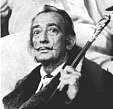 Dali |
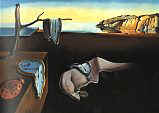 1931 |
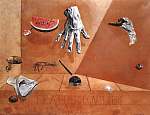 1947 |
 1983 |
| Antoni TÓpies was born on the 13th of December
1923. During the civil war he stayed in Barcelona. In 1940 he got a heart attack, after which he stayed for two years in the mountains
to recover. He finished his law-studies which he had followed for three years in 1946, to
dedicate himself to painting.
He is a
real self-taught man. During the years he got more experienced and the countries he
traveled to gave him inspiration. His home was and still is in Barcelona.
He is very much interested in other cultures,
Oriental religion, philosophy and art. In 1948 he was one of the establishers of the surrealist group "Dau al
Set", and he made illustrations for their magazine of the same name. One of their
goals was to give an impulse at Catalan modern art. Until the fifties his works were influenced by the surrealist works of Mirˇ and
others. After a few successful exhibitions he received a scholar ship from French government to come to Paris. In 1954 he married with Teresa Barba Fabrega and later they got a son and a daughter. TÓpies is best known for the abstract works he made from 1953 on. He uses all kind of materials like rope, plaster, sand, glue, wood and ironware. This style is called "material art" a form of abstract expressionism. The colors he uses are quite gloomy lots of brown and gray with a few brightly colored accents, against a background that often looks like a plastered wall. his themes are usually revolt against the Franco-regime, reluctance against industry, and a strong desire for the natural. Symbols and objects he uses are a chair, a cross and hieroglyphs. The old wall he often uses as a background symbolizes transitoriness and aging. From 1956 on he participated regularly at international exhibitions. In 1958 he received an important award in Venice. Starting at the end of the sixties he made anti-aesthetic art. During the sixties and seventies he wrote articles to defend freedom of expressing creativity, and his autobiography. During the seventies and eighties he made illustrations for books and designed posters. In 1990 his museum Fundacio TÓpies opened his doors. In this beautiful modernist building his works are displayed in a very nice environment. On top of the building stands his sculpture Nuvol i cadira,(cloud and chair) made out of kilometers of iron wire. He died February 8 in 2012. |
 Tapies |
 1967 |
 1981 |
 Nuvol i cadira |
| Pablo Ruiz Picasso was born on the 25th
of October 1881 in Malaga. As a three year old child he could better draw than talk. When
he was eight he made his first oil painting. His father was a good painter who taught at
art academies. When Picasso was fourteen years old, they moved to Barcelona where he
started studying at the arta cademy.( Barcelona would be very important for the young
Picasso, that's why I mention him on this page.) During this period he made a lot of
religious paintings. Thanks to the financial support of his family, he left in 1897 for Madrid to study
at the best academy of Spain. Until a few months later when he became seriously ill and
had to leave Madrid, he hang around on the streets and in bars and didn't go to school.
During his recovery he lived on the countryside and painted idyllic landscapes. A big
contrast were his paintings of his "Black period" which followed this period and
when he painted dark sad creatures as a result of the death of some people he loved. Around 1900 the cafÚ el 4 gats was very important to him and to many other famous
artists of that time. He held his first exhibition here, painted a poster and the menus
for the bar where he spent a lot of his time. When he was nineteen he left for the first
time to Paris, where he lived on the streets and in bars. He met an art dealer who was
interested in his work and who offered him a job. His life was very turbulent, he moved constantly from Paris to Barcelona, to
Madrid, to the coast of France. The same for his love life, he had lots of mistresses, and
lovers sometimes, got married, separated again, got three children. He was depressed many
times, because lots of the people he knew died young. He was fickle, needed a lot of
attention, egocentric and possessive but was very inventive, talented and could be very
charming. His art changed like his moods, when he was happy with a new woman his paintings
were optimistic, but when he was depressed his paintings showed angry, dark, distorted
figures. His art can be divided in different periods. The "Black period" at the end of the 19th century. He painted dark sad
creatures in front of a dark background. The"Blue period" lasted until 1904. He painted fringes and beggars in
blue. The "Pink period" was situated in 1905. It was a joyful period, and he painted all kinds of circus artists and harlequins in bright, warm colors. Around 1906 he was fascinated by three-dimensional objects, and made such paintings. Picasso is also one of the most important cubist painters. Starting at 1907 he and Georges Braque started experimenting with blocks and lines. Between 1907 and 1914 he painted cubist works in dark colors. After 1915 his style changed completely, now he painted realistic portraits and paintings of open windows in a neo-classical style. During the twenties he first made lots of portraits of his young son but then changed to painting monstrous and frightening figures in a surrealist style. His goal was to show the ugliness behind the glamorous world he lived in. At the end of the twenties he works with wrought iron too. Around 1930 his works got more classical again, but soon would change again as in 1936 the Spanish civil war broke out. All the horror of the war was expressed in Guernica a very large painting he has made for the world-exhibition in Paris. By this time Picasso was famous around the world. During world war II he kept painting distorted figures, especially women, with angry faces. His art was prohibited by the nazis, but although he had a difficult time he refused to leave Europe. He decided to become a member of the communist party. When the war had come to an end his paintings got less gloomy and he started to work with ceramics. He was commissioned by the peace movement to design posters and all kind of gadgets, with the pigeon as their symbol. From the fifties on he showed his interest in the works of old masters. Through the years he kept painting sometimes dark depressing paintings in dark colors. On April the 8th 1973 Picasso died of lung-and heartproblems in Mougins, France. Picasso had been very productive and versatile, he changed styles very often. He was (and still is) admired by many people and got very rich with his art. Practical information about the Picassomuseum in Barcelona.
|
 Picasso |
 1909 |
 1925 |
 1946-47 |
Home | Index | Practical info | Areas | Museums |Architecture | Modern art | Photos | Search
